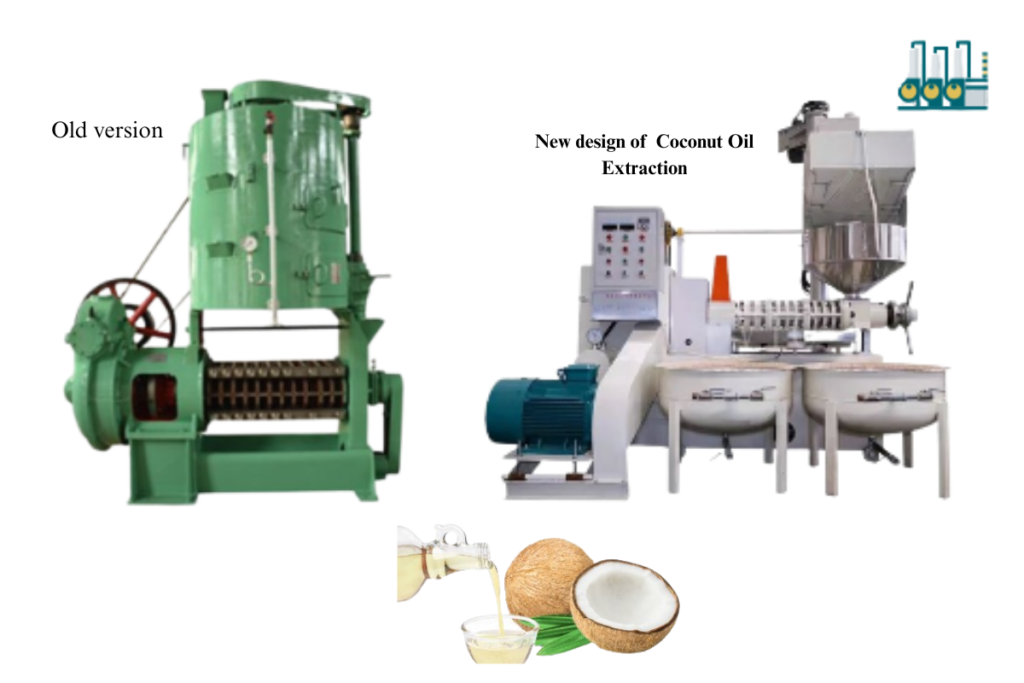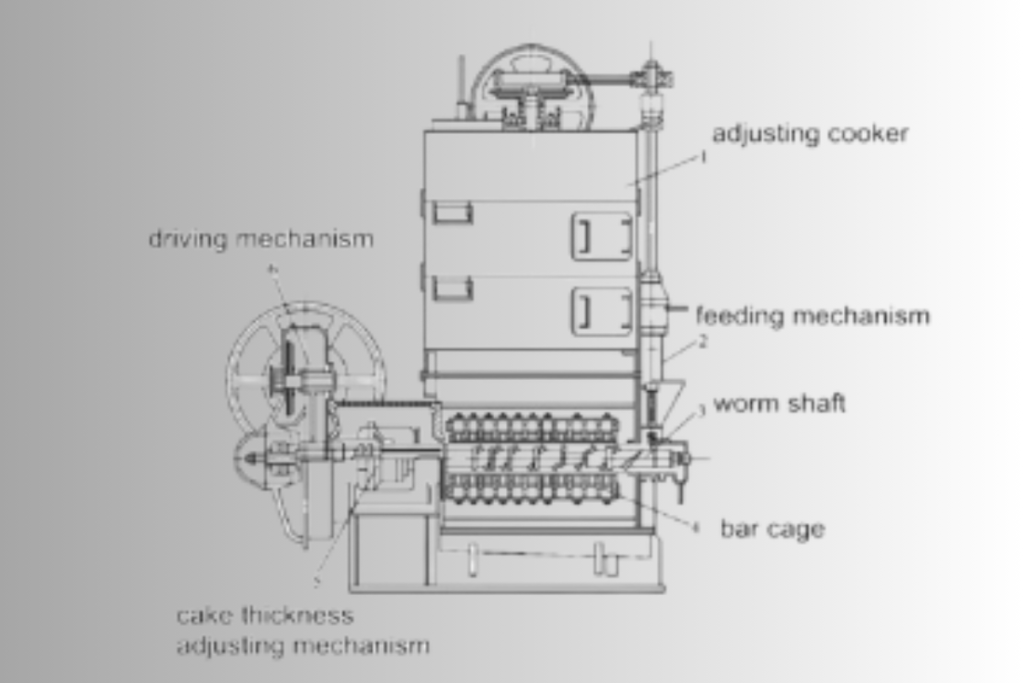Overview of the Coconut Oil Extraction
Table of Contents
Introduction to Copra Oil Expeller
The Copra Oil Expeller stands as a remarkable continuous oil press machine meticulously designed to fulfill the pivotal role in the coconut oil production line. Its primary function is twofold it caters to the initial pressing of copra and facilitates the subsequent pressing of pre-pressed copra cake, culminating in the extraction of high-quality coconut oil. This intricate process unfolds seamlessly, with automated and continuous operations encompassing copra feeding, copra cooking, oil pressing, and the discharge of pressed cake.
The versatility of this coconut oil press machine extends beyond its primary application with copra. It exhibits exceptional adaptability, proving equally effective in pressing a diverse range of oilseeds. Among the compatible seeds are peanut, sesame, sunflower seed, cottonseed, rapeseed, soybean, camellia seed, Tung seed, rice bran, flaxseed, and more. The Copra Oil Expeller is not confined to a singular purpose; it serves as a valuable asset for small and medium-scale oil plants, providing an efficient and reliable solution for oil extraction processes.

Features of Copra Oil Expeller
- Continuous Operation
The Copra Oil Expeller distinguishes itself with its ability to operate continuously. This ensures a consistent and streamlined production process, minimizing downtime and enhancing overall efficiency. - Automated Processes
Copra feeding, copra cooking, oil pressing, and cake discharging are seamlessly automated. This not only reduces manual intervention but also ensures precision and accuracy in each phase of the oil extraction process. - Versatility in Oilseed Processing
Beyond its specialization in copra, this machine showcases adaptability by accommodating a wide array of oilseeds. This versatility makes it a comprehensive solution for oil extraction from various sources. - High-Quality Coconut Oil Extraction
The Copra Oil Expeller is engineered to deliver optimal results in obtaining coconut oil. Its design and functionality are geared towards preserving the quality and purity of the extracted oil. - Suitability for Small and Medium-Scale Oil Plants
Recognizing the diverse needs of oil production, this expeller is tailored to be particularly suitable for small and medium-scale oil plants. It addresses the requirements of these operations, providing a cost-effective and efficient solution. - Seed Compatibility
The Copra Oil Expeller accommodates an extensive range of oilseeds, including but not limited to peanut, sesame, sunflower seed, cottonseed, rapeseed, soybean, camellia seed, Tung seed, rice bran, and flaxseed. This broad compatibility enhances its utility in diverse oil extraction processes.
The Copra Oil Expeller emerges as a comprehensive and efficient solution for oil extraction in the coconut oil production line and beyond. Its automated processes, adaptability to various oilseeds, and suitability for small and medium-scale oil plants position it as a valuable asset in the realm of oil processing machinery.
Structure and Working Principle of Coconut Oil Press Machine
- Components of Copra Oil Press
The Copra oil press is intricately designed, comprising several key components that work in tandem to ensure the efficient extraction of coconut oil. These components include the feeding mechanism, worm shaft, bar cage, cake thickness adjusting mechanism, adjusting cooker, and driving mechanism.
- Feeding Mechanism Responsible for the continuous entry of materials into the press.
- Worm Shaft Features seven sections of worms and six sections of intermediate collars, forming the core of the coconut oil making machine.
- Bar Cage Composed of various elements, such as cage loading plate, cage bar, convex cage bar, pressing plate, knife bar, spacer, and special bolts. Together, they shape the barrel necessary for the oil extraction process.
2. Operation of Knife Bar and Cage Bars
- Knife Bar: Positioned to correspond with the intermediate collar, the knife bar cooperates with it to facilitate the turning of materials. During the assembly of cage bars, it is crucial to align the edges in the rotation direction of the worm shaft.
- Spacers: Strategically placed between the cage bars, these spacers contribute to the formation of oil flowing gaps within the bar cage.
3. Working Principle of Coconut Oil Expeller
- Materials from the feeding mechanism enter the barrel continuously as the process initiates.
- The worm shaft, rotating anticlockwise, propels the materials forward through the barrel.
- As the barrel volume decreases, the materials undergo compression, leading to the extraction of oil.
- The pressed oil flows out through the gaps between the cage bars, resulting in the separation of oil from the materials.
Points to Note!
- Material Flow The entire process is characterized by a continuous flow of materials through the system, ensuring a seamless operation.
- Compression and Oil Extraction The decrease in barrel volume plays a pivotal role in compressing the materials, ultimately leading to the extraction of oil.
- Cage Bar Configuration The careful arrangement of cage bars, knife bars, and spacers is essential for creating the necessary conditions for effective oil extraction.

Operation of the Coconut Oil Making Machine a Comprehensive Guide
The efficient operation of the coconut oil making machine involves a series of carefully orchestrated steps to ensure optimal oil extraction. Here’s a detailed guide on the operation of the machine
1. Preheating the Adjusting Cooker Begin by preheating the adjusting cooker of the copra oil press. This crucial step sets the stage for the subsequent processes.
2. Loading Materials into the Adjusting Cooker Once the adjusting cooker is adequately preheated, introduce the materials into the cooker. Ensure that the discharge door at each layer closes automatically, creating a controlled environment for the subsequent stages.
3. Feeding Materials to the Barrel Initiate the feeding process to the barrel. Start with a small quantity of materials and gradually increase the feed. This incremental approach ensures a smooth and controlled progression of the oil extraction process.
4. Managing Cake Shape the cake appears shapeless during the process, introduce direct steam onto the materials. This step is particularly useful in maintaining the integrity and form of the cake as it progresses through the coconut oil making machine.
5. Adjusting Cake Thickness As the barrel temperature rises, carefully monitor and adjust the thickness of the cake. This step allows for precise control over the extraction process, ensuring optimal results.
6. Recooking and Repressing High Oil Content Cake For cakes with a high oil content, consider a recooking and repressing process. The coconut oil making machine is equipped to handle this scenario, offering a practical solution to maximize oil extraction from high-content cakes.
Considerations for Operation
Gradual Material Feeding The gradual increase in material feed ensures a controlled and efficient oil extraction process. Temperature Monitoring regularly monitor the barrel temperature to facilitate timely adjustments and maintain optimal processing conditions. Shape Retention for Cake The introduction of direct steam is a strategic measure to preserve the shape and structure of the cake during processing. Adaptability to High Oil Content Cakes The machine’s capability to recook and repress high oil content cakes highlights its versatility and efficiency in handling varying material compositions. By following these detailed steps and considering key operational considerations, users can harness the full potential of the coconut oil making machine for consistent and high-quality oil extraction.
More information Soybean Oil Production ProcessEdit